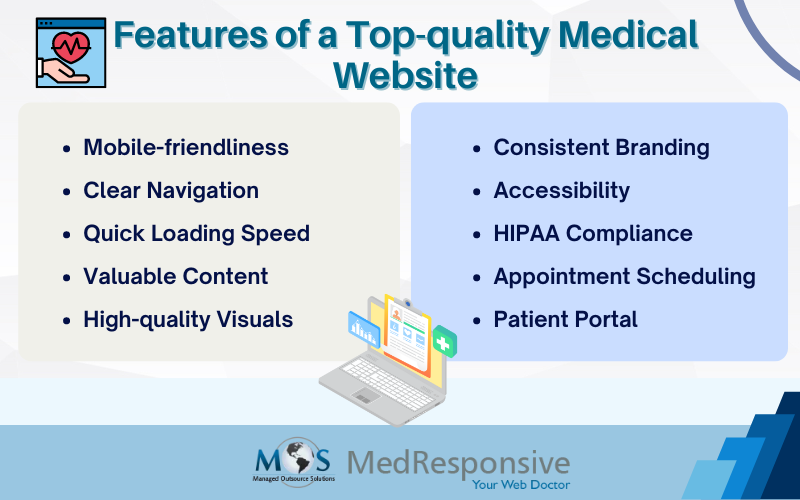Web development plays a pivotal role in the success of healthcare businesses in today’s digital age. A professionally designed and well-maintained website is not just a virtual presence but a vital communication and engagement tool. It serves as a primary gateway for patients, providing them with essential information about services, medical professionals, and appointment scheduling. Moreover, a user-friendly and informative site instils confidence and trust in potential patients by reflecting the professionalism and quality of care that the healthcare business offers. An experienced provider of professional website development services can help healthcare entities in developing an easily navigable website with advanced features.
Importance of Having a Well-designed Healthcare Website
When they are seeking medical services, people want to be able to verify services, compare physicians, and read reviews and recommendations about them. Most first look up website reviews before contacting a healthcare provider by phone. This emphasizes how important it is for every medical entity to have a high-quality website. Building a healthcare website involves much more than only producing clickbait:
- Smooth communication: Medical facilities can communicate with patients after business hours using AI-powered chatbots on their website.
- Competitive advantage: Investing in healthcare website development can give you a competitive advantage. Enhance UX, add contemporary features, and customize, and you stand a decent chance of creating a distinctive brand that inspires confidence.
- A source of knowledge: Your websites will be your clients’ initial “call” for any health-related questions. High-quality material on websites of medical institutions rank next in terms of trustworthiness. One reliable way to draw readers and convert them to customers is to create a blog and post informative content on a regular basis.
- Manage scheduling: In addition to being more convenient for patients, online scheduling also frees up administrative workers and lowers the number of no-shows. Patients can conveniently schedule, reschedule, or cancel appointments using an online appointment system, which maximizes the use of medical resources.
- Integration of telehealth: Hospitals can extend their services to remote and underserved rural areas by integrating telehealth services through web development.
Best Practices for Website Development
- Mobile-Friendliness: Statista estimates that, in 2023, mobile users will make up roughly 58.7% of all website visitors worldwide. It’s clear why mobile friendliness is a must. If responsive design features aren’t incorporated into your medical website, you’re essentially throwing away half of your potential traffic. You must thus make sure that your website will adapt to the screen sizes of tablets and mobile devices in the same way that it does for PCs.
- Clear Navigation: Efficient navigation is another essential component of healthcare website design. Make sure those who visit your website can navigate it easily and sensibly. If not, they’ll leave fast. Make sure the most important pages are displayed in the navigation so that users can quickly access all the pertinent information. Incorporate obvious call to action (CTAs) into the design so that users can quickly identify links to sections that assist them in completing an action.
- Quick Loading Speed: 25% of users will leave a website that takes longer than 4 seconds to load, according to an article by Website Builder Expert. Some may depart even earlier. Effective websites have a quick load time. The simplest method to guarantee that your website loads rapidly is to have the frontend and backend created with speed in mind, and to keep improving the code even after the launch. In general, you will need to consider:
- Database enhancement
- Web hosting with caching
- Compression of files
- Minification
- Reduction in redirects
- Networks for delivering content
Even though it could seem intimidating at first, it’s best to start off right and enjoy the benefits of meticulous medical website building.
- Valuable Content: Sharing helpful content for patients and medical professionals is crucial. Whether it’s hospital website or a doctor’s website, the goal should be to showcase your competence and inspire confidence in prospective patients. To achieve this goal, consider updating the following sections on a regular basis:
- Frequently Asked Questions
- Testimonies
- Blog entries and content related to thought leadership
- Health-related news
- Relevant business data
- High-Quality Visuals: To make a lasting impression on visitors, ensure your site has unique pictures and high-quality visuals. A Website Builder article noted that a website’s visual appeal is crucial to drawing in and keeping visitors. “Users form their first conscious impression of a website in 2.6 seconds, with visuals and design accounting for 94% of the first impressions.” Your audience will understand the quality of your goods and services through visually appealing graphics. Post images of your physicians, images of your facility, and other pertinent visual content that will support your professional image.
- Consistent Branding: Consistent branding is essential for medical websites. Basically, it’s about using consistent designs across all of your products to make your organization clearly recognizable. Verify that components such colours, fonts, images, logos and graphics as are consistent throughout your website to ensure you’re projecting professionalism. Staying true to your brand’s language and imagery will make a lasting impact on potential customers and boost the chance that they will visit your facility.
- Accessibility: It is important to make sure a website is accessible for different user groups, such as medical professionals, patients, or pharmaceutical businesses. This entails creating and developing your website in a way that makes it easy for all users—especially those with disabilities—to view, comprehend, navigate, and engage with your information. To do so, take the following factors into account:
- Adherence to the guidelines for web content accessibility
- Keyboard guidance
- Compatibility with screen readers
- Alternative texts for non-textual content
- Readable and comprehensible content
- Responsive design
- contrast in color
You can build a website that is more inclusive by incorporating these accessibility best practices. Enabling patients to receive and benefit from the information and services supplied is important because they may be in a vulnerable state at some point.
- HIPAA compliance: If your website collects or stores any patient information, it’s important to comply with the Health Insurance Portability and Accountability Act (HIPAA) regulations. Implement appropriate security measures, encryption, and privacy policies to protect sensitive data.
- Appointment scheduling: Integrate an online appointment scheduling system to allow patients to book appointments conveniently. Provide a user-friendly interface and include features such as appointment reminders and notifications.
- Patient portal: Consider implementing a secure patient portal where patients can access their medical records and test results, and communicate with healthcare professionals. This can enhance patient engagement and streamline communication.





